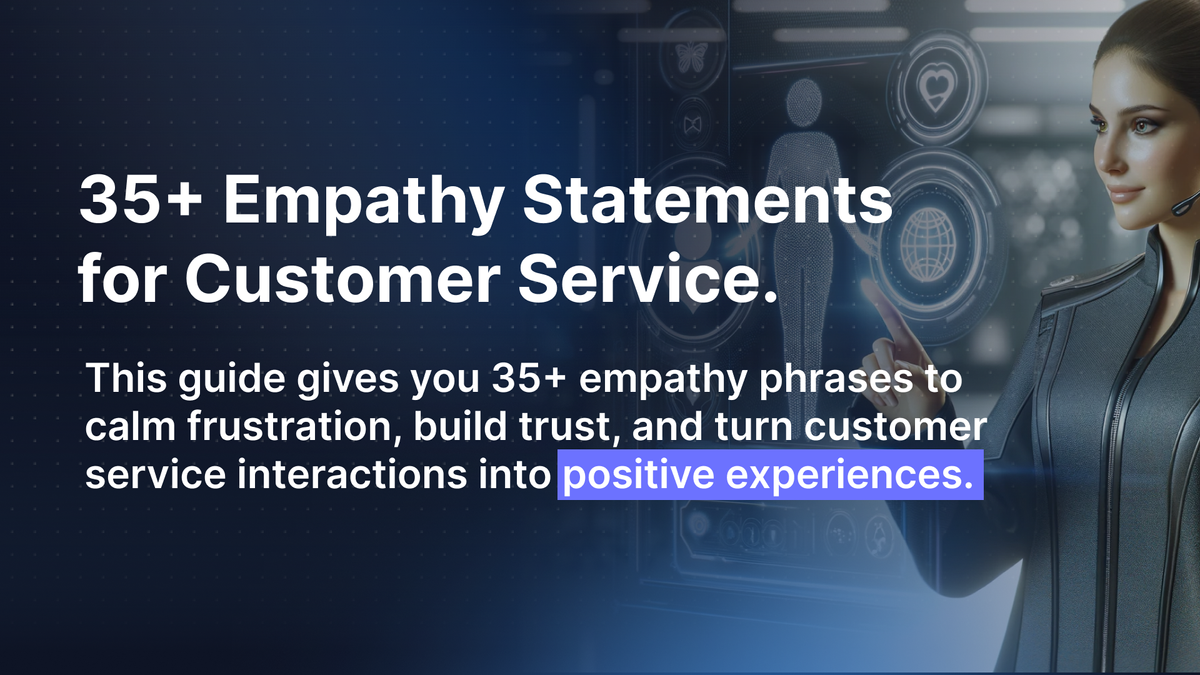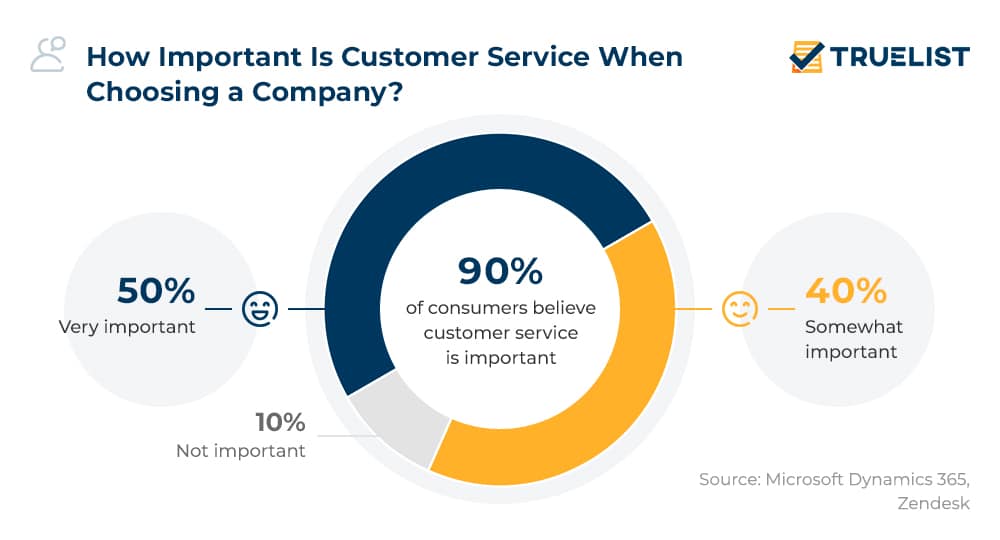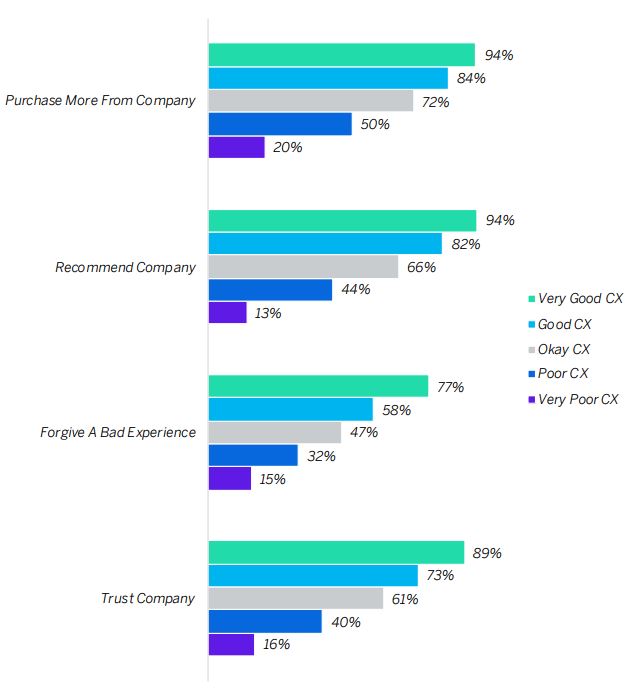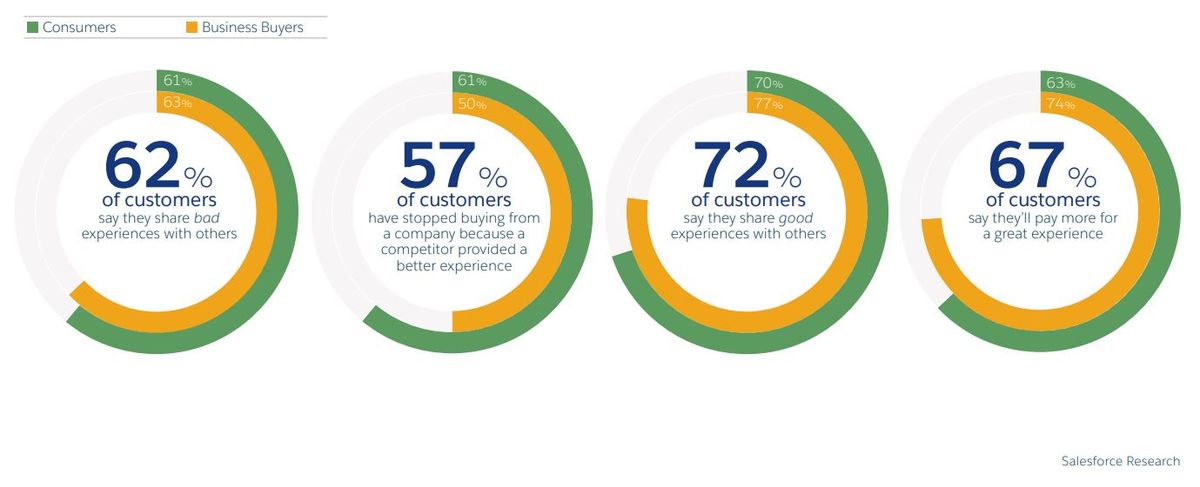Turn angry customers into a loyal community! This guide gives you 35+ empathy...

We have all heard that kindness doesn't cost a dime, but what does that actually mean? Kindness in customer service goes beyond being nice. It's about using empathy to connect with customers, understanding their feelings, and using words that acknowledge their situation. This creates a bond that builds trust and loyalty. The use of empathy statements is not just a nicety but essential for navigating difficult situations and people going through emotional distress.
The use of the right empathy statements can defuse tension and turn a bad situation into a positive one. Here are 35 examples to use throughout the customer journey, from addressing complaints to processing returns. These include phrases for validating customer frustration, taking ownership of issues, and offering solutions.
Imagine yourself as a customer dealing with customer service of different companies, each addressing a complaint you have encountered. At company A, the CSR sounds impersonal and disinterested. They rush you through the steps, offering a standard return procedure and resolving the complaint abruptly.
On the other hand, the representative at company B is a lifesaver! They understand your frustration, greet you with empathy statements, apologize for the trouble, and listen patiently. Then, they work with you to find a solution until you are happy and satisfied. So, who is more likely to get your future business?
Empathy in customer service is understanding and connecting with customers' feelings and perspectives. It's about seeing things from their point of view, acknowledging their emotions, and using that understanding to deliver better customer service.
In simple words, empathy is the ability to put yourself in another person's shoes and understand their emotions and experiences. Empathy in customer service is extremely important as it allows representatives to connect with customers on a deeper level and understand their needs better, which leads to happier interactions, increased customer satisfaction, and better brand loyalty.
Here are some of the key reasons why empathy makes a difference in customer service:
According to research by Microsoft, 90% of Americans and 97% of customers worldwide say customer service is the key differentiator in their decisions. When a CSR shows empathy, they acknowledge customers' frustrations and validate their feelings. This makes customers feel heard and respected, leading to a more positive experience and increased customer satisfaction.

Research shows that satisfied customers are more forgiving. Empathy statements help customer service de-escalate situations. By acknowledging the customers' feelings, the CSR demonstrates that they're on the same page, reducing tension and creating a more collaborative problem-solving environment. Nearly 80% of customers will forgive a bad experience if the customer experience is very good.

It is important to remember that 57% of customers stop buying from a company because a competitor provides them with a better experience. Positive empathy statements help build trust and create a more positive experience for everyone.
By saying something like "I understand your frustration" or "That must be inconvenient," the rep shows they care. This validation builds trust and calms them down; even if the problem can't be solved perfectly, the customer walks away feeling better about the experience.

Compassion and empathy statements work like a secret tool for building brand loyalty. Happy and satisfied customers are more likely to stay with your brand, make repeat purchases, and recommend it to others (75 %). This brings you increased sales and business opportunities.

Customer complaints, returns, cancellations, and negative reviews are all part of a regular business. Even the most thriving businesses have to face challenging circumstances. The key is to acknowledge their frustration with empathy and positive attitude.
Here, we have shortlisted 35+ empathy phrases for customer service for you to utilize at different stages of the customer journey. These empathy statements will help you win at customer service and build lasting relationships.
Customer complaints/ queries are an inevitable part of any customer service. When a customer voices a complaint, their biggest need is to feel heard and understood. Here are some appropriate empathy statements to use in such situations.
When a customer is frustrated, the most important thing is acknowledging their frustration before moving towards solutions. The above phrase validates their feelings and lets them know you are paying attention. It shifts the focus from anger to a solution, offering a helping hand and de-escalating the situation.
This short phrase shows empathy and a willingness to find a resolution. It calms the customer and opens the door to a productive conversation.
This is a highly effective empathy statement for angry customers as it tackles two crucial aspects of their frustration, i.e., validation and shared experience. It shows that you understand a customer's disappointment without blaming them, and their feelings are justified.
This combination of acknowledging their emotions with accountability helps build rapport, demonstrates empathy, and ultimately de-escalates the situation.
An angry customer wants you to walk in their shoes and take ownership of the situation. Empathy statements like the phrase above enable you to offer help and assure them you will work to fix it. It goes beyond just listening and shows that you are actively invested in their satisfaction.
Empathy statements are meant to diffuse tension and build trustworthy relationships with customers. The above phrase lets you do both effortlessly and helps you position yourself as a teammate with a solution-oriented approach. When customers feel like you are on their side and understand their situation, they are more likely to trust you and work with you to find a solution.
This is a simple, direct, yet powerful statement. It is a straightforward acknowledgment that customers didn't get what they expected without blaming or sugarcoating. It assures them you're not just registering their complaint but actively working to get them the promised outcome.
In a customer service situation, the customer may not always be right, but sometimes, the best course of action is to de-escalate the situation. Here is how this is one of the best empathy statements for such situations:
A product or service failure can happen for any reason, such as a software glitch, communication mishap, or other external factors. Either way, it can damage a customer's trust and your business's reputation in the long run. Empathy statements from customer service show a genuine desire for help and turn negative experiences into positive ones.
Let's take a look at some of the winning empathy statements to use in similar situations:
This empathy statement directly addresses the issue and expresses regret for the situation. Words like "malfunctioning" and "inconvenience" acknowledge the customer's problems and the disappointment it likely caused. The second part shows your willingness to help and how you are actively trying to find a solution and a speedy fix for the customer.
This is a good start to empathize with your customers by acknowledging the issue and the value of feedback. Here's why an apology isn't always necessary and how this statement achieves empathy through appreciation:
This empathy statement tackles a product issue while politely encouraging the customer to provide more details. It acknowledges the problem from the customer's viewpoint using "It appears" to soften the language and "unexpected issue" to suggest it wasn't anticipated.
By acknowledging the problem, highlighting its unexpected nature, and requesting details in a polite way, this customer is requested to open up and share their experience for an accurate resolution.
While it is important to ensure customers that you are actively working to find a solution, avoid making fake or unrealistic promises when you don't know how much time it will take. The above statement shows empathy for slow loading times and understanding of the customer's inconvenience.
At the same time, it appreciates customers' patience and understanding, assuring them that a solution is on its way without making a time-bounded commitment.
Businesses can't stock every product all the time. However, limited availability can be frustrating for customers. The above statement tackles inventory management challenges while keeping a solution-oriented approach. Asking, "Is there anything else we can offer you in the meantime?" shows your willingness to find an alternative and keep the customer engaged, demonstrating that you value their business despite the limited stock.
Well-crafted empathy statements help you deal with customers' frustration in a professional manner. To avoid further frustration and create a receptive environment, take accountability for your shortcomings and avoid blame shifting. Instead of offering generic solutions, prioritize customers' needs and empower them to suggest a preferred solution. This personalization shows a genuine desire for a resolution that truly satisfies the customer.
There could be many reasons a customer might want to cancel their order or bookings. It could be a subscription they no longer need, a trip that needs rescheduling, or an online purchase that doesn't fit in anymore. In these situations, it's good for a business to support their customers besides sales and purchases and assure them that they will always be welcomed whenever they are back. Here are some empathy statements for the cancellation process:
Cancellations can feel awkward for customers. They might worry they're causing trouble or that their reason isn't valid. Take the pressure off the customer by acknowledging the potential awkwardness of canceling and making it seem normal. The above statement assures customers that their situation is understandable, as circumstances can evolve quickly.
This normalizes cancellations and puts the customer at ease by showing the business is there to help, not judge.
Research shows that only 1 in 26 customers complain, and the rest don't say anything. This means your silent customers can be more damaging than those who voice issues. While cancellations are unavoidable, proactively reach out to your customers to discover potential flaws that might be the driving factor behind them.
This feedback helps identify internal problems and allows you to improve processes to prevent future customer churn. It's better to catch and address issues before they lead to a wave of silent cancellations.
A little validation goes a long way. Customers often feel like they need to justify a cancellation. This validation reassures them that their reasons are valid and their needs might have simply changed. Empathy statements like this show the company understands their circumstances and prioritizes their satisfaction, even during a cancellation.
Cancellations can be a huge disruption for traveling businesses, but you can still offer empathy and a win-win solution with the above statement. Present both rescheduling and refund options to choose from. Rescheduling offers a chance to salvage the trip for them, while a refund respects their situation. This approach focuses on flexibility and shows the business prioritizes customer satisfaction over just minimizing their own hassles.
This statement highlights flexibility. It acknowledges a potential product/service mismatch by offering to "swap" their current choice. This shows the customer you're not just focused on the cancellation but on their overall satisfaction. By suggesting alternatives, you offer a chance to resolve the issue and potentially retain their business.
A client business relationship should go beyond sale and purchase and focus on building long-term connections. The business conveys a sense of trust and respect by assuring customers that cancellation doesn't affect the relationship. The invitation to "repurchase or rebook" lets the customer know they're still valued and welcome if their needs change in the future.
Returns/ refunds are the process where empathy and understanding are most needed. Don't let the customers feel inconvenienced or let down by your business. Acknowledge their concerns and show that you value their experience. This shows your willingness to improve and provide a better customer experience.
Here are some of the most impactful empathy statements for the refund or exchange process:
A simple and powerful statement that directly addresses the customer's situation without unnecessary explanation. When your SOPs clearly allow the return, there is no need to dwell on reasons for the return or go into apologies. Guide the customers through the process for a smooth return.
The best empathy statements take full responsibility for customers' experience and offer adequate support. The above statement stands out with ownership and a flexible approach towards customer support. It also empowers the customer by offering both a return and exchange, acknowledging their preference for the resolution.
The strength of "Sometimes things don't go as planned..." lies in its simple empathy. It acknowledges the customer's situation without dwelling on blame. Offering "return options" enables them to choose the best path (refund, exchange), regaining control.
Another example of an empathy statement that prioritizes customer satisfaction by acknowledging their value. It respects their decision by not pressuring them to keep the order and focusing on a smooth resolution, minimizing further inconvenience.
Every single interaction in customer service is an opportunity to learn and grow, even your mistakes. This phrase reframes the return as an opportunity to improve customer experience. Focusing on a positive experience opens the door for future business; a positive resolution makes customers feel valued, and they are likely to come back for a purchase.
Even your best-selling product may not be a good fit for someone. Validate the customer's experience by admitting the product wasn't ideal for them and appreciate them for their time and effort even if they don't make a purchase. It subtly builds a bridge for future interactions and leaves a positive impression that might influence them to consider you again when their needs better align with your offerings.
As per research by Esteban Kolsky (customer experience expert), 13% of customers will tell 15 or more people about their negative experiences. To catch these concerns early, appreciate all feedback you receive from customers, both positive and negative.
Empathize with customers who share negative reviews and assure their feedback is valued. Let's see how you can do that with these empathy statements:
An intelligent empathy statement without saying sorry to the customer. This statement validates the customer's experience without directly admitting fault. It shows you understand their frustration, and the situation wasn't ideal. By focusing on "shouldn't have happened," you take responsibility for the outcome without assigning blame.
After you acknowledge customers' frustration, shift the focus towards the solution. Take responsibility by offering multiple options (A or B ). It personalizes the approach and empowers the customer to choose the best fit for their situation. This shows a proactive and positive effort to find a satisfying outcome.
Order delays can be extremely frustrating for customers and cause anxiety. A timely and empathetic response shows you understand their problem and are taking immediate action. This helps calm them down and builds trust. Offer the maximum possible help and keep them updated with information regarding their order.
Empathy and concern should go beyond just fixing the problem. Let your customers know that you are invested in their complete satisfaction. It ensures they feel comfortable raising any doubts and creates a positive customer service experience that goes the extra mile.
This statement hits all the key points in a concise way. It takes responsibility by not making excuses and focuses on the solution ("replacement right away"). This reassures the customer that the mishap is being addressed promptly and minimizes any further inconvenience.
Positive feedback is equally important. The above statement shows appreciation and highlights the motivating power of customer satisfaction. This positive interaction reinforces the value of good customer service and encourages the team to provide exceptional customer experience.
Beyond online shopping, customer service in healthcare, finance, or law often deals with emotional distress. A little empathy can bring comfort and make a big difference in these challenging situations. Here are some empathy statements for specific situations that can help you deal with people navigating complex emotions.
Customer support is never a straightforward path. Customers come with a range of emotions that sometimes take over the logic. However, empathy can help you bridge this gap and develop a connection with them based on trust and loyalty. This article provides a comprehensive collection of empathy statements you can use throughout the customer journey, from addressing complaints to processing returns. These carefully chosen phrases can benefit even specific industries like healthcare or law.
The rise of AI support and AI customer service has further enhanced empathy in customer service. Chatbots can identify customer pain points, allowing businesses to stay ahead of the curve. Using these empathy statements through AI chatbot customer service helps you deliver a more humane and fulfilling customer experience.
Sympathy means feeling sorry for the customer, while empathy allows you to understand their feelings more deeply. In customer service, empathy is better. It allows you to solve problems and foster long-term relations, while sympathy might be superficial.
Empathy statements in customer service are key because they show you understand customers' emotions, whether frustration or joy. While hard skills for customer service, like product knowledge, are essential, empathy builds trust and calms them down.
It lets customers know you're on their side and working for a solution, leading to happier customers and better experiences.
Here are some ways you can communicate empathy with customers through different channels:
Role play: Simulate real-world scenarios that portray frustrated customers, allowing staff to practice empathetic responses.
Scenario Analysis: Discuss real customer complaints as a team, identify opportunities to express empathy, and brainstorm effective solutions.
Active Listening Exercises: Train staff to listen to customer concerns, identify emotions, and respond with validating statements.
All an angry customer wants is for someone to listen to them patiently. Acknowledge their frustration ("I understand you're upset"). Validate their feelings ("This must be inconvenient") and then offer a solution-oriented approach ("Let's work together to fix this").
Your customers want to be heard and understood. Customer service without empathy is nothing but impersonal and robotic interactions that don't cater to customers' needs, forcing them to take their business elsewhere.
Yes, AI can analyze conversations to identify recurring issues and suggest appropriate responses, including empathy statements. While AI can't truly feel empathy, it can be a tool to improve customer service interactions and make them feel more human.